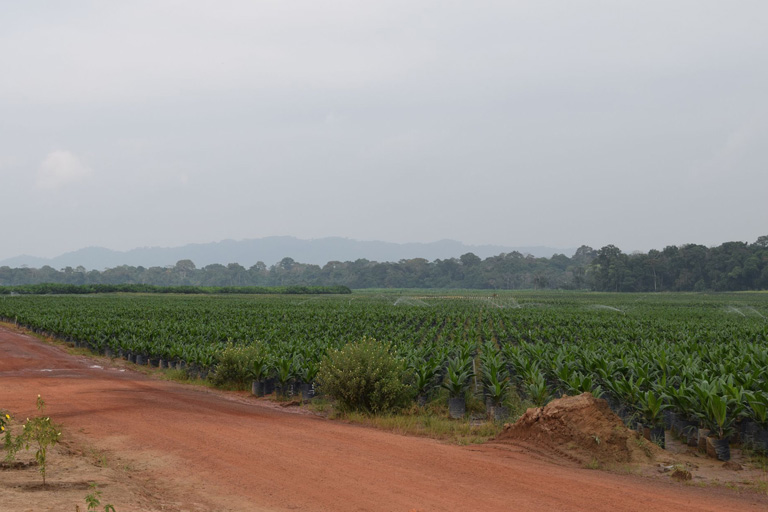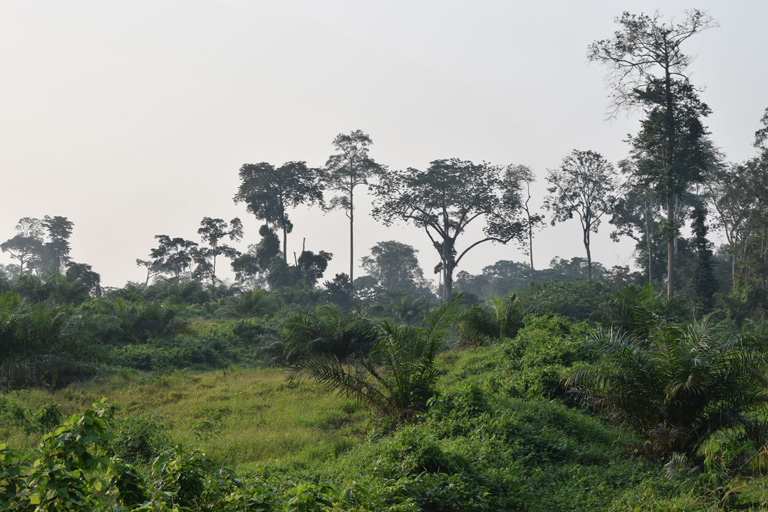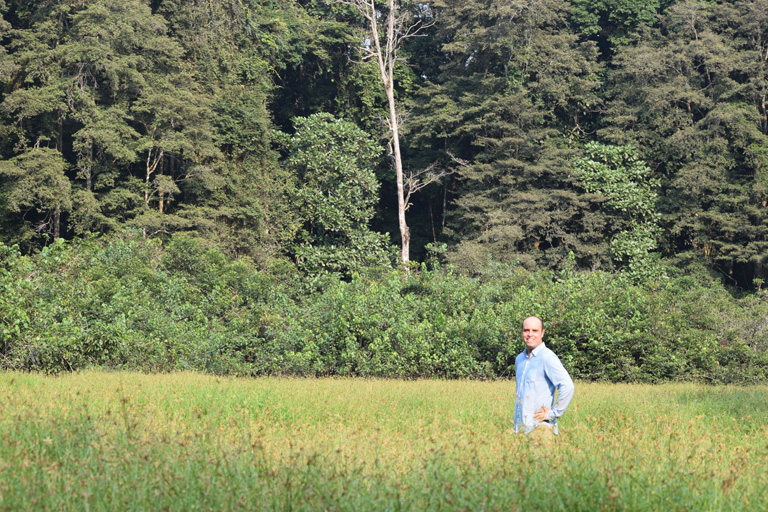- Gabon remains a relative stronghold for endangered wildlife like chimpanzees and forest elephants.
- Singapore-based Olam International, one of the world’s largest agribusinesses, has agreed not to plant palm oil in protected wetlands, and also set aside conservation areas and corridors for wildlife in its concessions in Gabon.
- But there is only so much that can be done to minimize the impact of clearing 26,000 hectares in the middle of one of the world’s most forested countries.
- This post is a commentary. The views expressed are those of the author, not necessarily Mongabay.
The chimpanzee nest was a few months old, but there it was, right next to the tracks of the endangered forest elephant. We were in a conservation area that had been protected by Singapore-based Olam International, one of the world’s largest agribusinesses. But just 100 yards away, there was no more forest, no more chimpanzees, and no more elephants. Instead monoculture palm oil plantation spread almost as far as the eye can see grown palm oil used as a common additive in everything from doughnuts to shampoo.
We were in Gabon, a densely forested country on Africa’s Atlantic Coast, which remains a relative stronghold for endangered wildlife like chimpanzees and forest elephants. Olam’s plantation is far from the world’s worst: Olam has agreed not to plant palm oil in protected wetlands, and also set aside conservation areas and corridors for wildlife. The company has worked closely with local communities to minimize the negative impacts of its plantation on water quality and traditional access, invested in some smallholder agriculture, and respected at least some communities’ decision to refuse to allow the plantation to extend into their traditional lands. While the company is still expanding into savannah areas, it has also set aside several thousand acres of these highly biodiverse landscapes.


But there is only so much that can be done to minimize the impact of clearing 26,000 hectares in the middle of one of the world’s most forested countries. From a climate perspective, that amount of deforestation is simply incompatible with achieving reductions in greenhouse gas emissions. For wildlife, despite the conservation corridors, the forest elephants simply can’t access all their usual habitat. They are then forced into the pathway of local communities, creating potential for human-elephant conflict.
And as much as Olam has done to try to protect water sources, the company is still using a large quantity for their nurseries and irrigation, in some cases impinging on access to water for communities. To be sure, Olam has created 6,500 jobs in palm oil.. But the project is inevitably disrupting village life. Gabonese culture is intertwined with the forest: every morning and evening, hunters head out into the forest to find food, villages depend on the forest for clean water and medicine, and it is the site of traditional religious practices, which remain widespread. But where there are plantations, young people are moving away from the villages to live on the plantation or in the nearby town of Mouila. Olam’s rubber plantations in Bitam in the north of Gabon have had similar effects on both the ecology and communities of the area.
In other words, Olam’s plantation is almost as well-executed as a large-scale plantation in a forest landscape could be, but it’s still not pretty.


Ultimately, the tragedy of this kind of deforestation is that it is entirely unnecessary: In the tropics alone, there are more than one million square kilometers of previously deforested lands where agriculture can be expanded without threatening native ecosystems – far more than is needed to meet human agricultural demand for decades to come.
Most countries – even ones with vast remaining forests like Brazil, Bolivia, and Indonesia – have lots of these degraded lands where they can expand agriculture. Some have made significant efforts to focus agricultural development there: for instance, Brazil has virtually eliminated deforestation for soybeans in its part of the Amazon, even as it has expanded the area planted with soy by 2.6 million hectares in the last ten years. In most countries, large-scale agricultural development doesn’t have to come with such negative environmental costs.
However, there are a handful of countries that, for one reason or another, have done such a good job of protecting their forests over the centuries that it’s difficult to develop large-scale plantations without deforestation. In Gabon , 85% of the nation is a sea of green from the ocean all the way inland. Ecologically, these large-scale forests are considered the most important to protect. Some companies argue that conservation standards should be lowered for high forest cover countries like Gabon so they can benefit from large-scale plantation agriculture. And governments are tempted by the money that can come with industrial agricultural development. In Gabon, for instance, the government is eager to diversify its economy away from its heavy reliance on its oil reserves.
But these countries face two realities: first, when industrial agriculture starts, it’s hard to keep it under control. Most large plantation companies have an insatiable appetite for land, and the willingness to do whatever it takes to acquire and convert forests. Second, in today’s global marketplace, people simply don’t want to buy food or soap that’s grown by destroying elephant and chimpanzee habitat. Indeed, we and our Gabonese partner Brainforest were able to persuade Olam to declare a one-year moratorium on deforestation largely by rallying the large global food companies that purchase raw materials from Olam, as well as Olam’s investors, to demand that the company cease deforestation. It worked: while it still has a lot to do, Olam has now started to act on its pledge to chart a more responsible future for its operations in Gabon.


Other companies that have sought to establish large-scale plantations in forest regions of Africa have either had to curtail their plans after facing NGO campaigns and hostility from local communities and investors. Others, like GAR and Sime Darby in Liberia and Wilmar in Nigeria have implemented the High Carbon Stock methodology for identifying degraded lands where agriculture can be developed while protecting forests. It’s insane to put a huge monoculture plantation in the middle of one of the world’s last intact rainforests when there are so many places agriculture can be expanded without deforestation. As a result, companies and countries that engage in deforestation increasingly just cannot find reliable, high-value markets for their goods, or even attract large-scale investment into their agriculture and forestry sectors.
The good news for high forest countries like Gabon is that prosperity does not rely on destroying forests for large-scale plantation agriculture. Indeed, deforestation is antithetical to development. Instead, countries like Gabon can diversify their economies while protecting their resources for their people for the long term.


Smallholder production of high-value crops like cocoa and coffee is one option that could dramatically increase high forest cover countries’ revenue without deforestation, if managed well. High forest cover countries like Bolivia, Papua New Guinea, and Gabon, all have long histories of successful smallholder production of crops like cocoa, coffee, and coconut, which don’t require deforestation. There can even be a role for companies like Olam to bring professional expertise and market access to the cultivation of these crops.
In addition, high forest cover countries have the potential to become ecotourism meccas with a bit of concentrated effort and investment. People from all over the world want to visit national parks where they can see amazing creatures like forest elephants, chimpanzees, and gorillas. Rwanda has 600 gorillas, but attracts hundreds of millions of dollars a year from gorilla tourism. Kenya, Tanzania, and South Africa have even bigger eco-tourism businesses.

Gabon, in contrast, has more than 30,000 gorillas but receives very few tourists each year. The Gabonese government has developed highly sophisticated plans for sustainable eco-tourism, but they have not deployed them yet. In order to develop their potential, the government would have to do away with its existing onerous visa requirements, which have the effect of discouraging tourists, and also end poaching: in places where wildlife are under significant hunting pressure, they are much less likely to show themselves to humans, making the visits less attractive to potential tourists.
Donor governments can play an important role in helping countries like Gabon remain forested. While most investment for forest conservation has gone to combatting deforestation where agriculture is already expanding on a grand scale, countries like Gabon, Republic of Congo, and Laos could all be eligible for enduring financial incentives to continue protecting their forests, presuming they enact needed reforms. Gabon is off to a good start: the Norwegian and French governments just provided $18 million in funding through the CAFI initiative to support Gabon’s forest conservation efforts. In turn, Gabon reduced the area under logging concessions by half, and took a range of other forest conservation measures.
Combined, high value crops produced by smallholders, ecotourism, and increased international support can provide an economically viable pathway for forest countries to achieve prosperity while maintaining their forests intact.
There are many fewer of these vast intact forests than there were even a decade ago. The ones that remain should be all the more prized. Companies and countries alike should be investing as many resources as necessary to ensure that these forests last long into the future.


